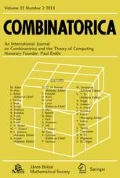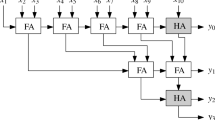Abstract
In this paper we give a new upper bound on the minimal degree of a nonzero Fourier coefficient in any non-linear symmetric Boolean function. Specifically, we prove that for every non-linear and symmetric f: {0, 1}k → {0, 1} there exists a set; \(\not 0 \ne S \subset [k]\) such that ¦S¦ = O(Γ(k)+√k, and \(\hat f(S) \ne 0\) where Γ(m)≤m 0.525 is the largest gap between consecutive prime numbers in {1,..., m}. As an application we obtain a new analysis of the PAC learning algorithm for symmetric juntas, under the uniform distribution, of Mossel et al. [10].
Our bound on the degree is a significant improvement over the previous result of Kolountzakis et al. [8] who proved that ¦S¦=O(k=log k).
We also show a connection between lower-bounding the degree of non-constant functions that take values in {0,1,2} and the question that we study here.
Similar content being viewed by others
References
N. Alon, O. Goldreich, J. Håstad and R. Peralta: Simple construction of almost k-wise independent random variables, Random Structures and Algorithms 3 (1992), 289–304.
R. C. Baker, G. Harman and J. Pintz: The difference between consecutive primes, II, Proceedings of the London Mathematical Society 83 (2001), 532–562.
A. Blum and P. Langley: Selection of relevant features and examples in machine learning, Artif. Intell. 97 (1997), 245–271.
A. L. Blum: Relevant examples and relevant features: Thoughts from computational learning theory, in: In AAAI Fall Symposium on ‘Relevance’, 1994.
H. Cramér: On the order of magnitude of the difference between consecutive prime numbers, Acta Arithmetica 2 (1936), 23–46.
G. Cohen, A. Shpilka and A. Tal: On the degree of univariate polynomials over the integers, in: Innovations in Theoretical Computer Science (ITCS), 409–427, 2012.
J. von zur Gathen and J. R. Roche: Polynomials with two values, Combinatorica 17 (1997), 345–362.
M. N. Kolountzakis, R. J. Lipton, E. Markakis, A. Mehta and N. K. Vishnoi: On the Fourier spectrum of symmetric Boolean functions, Combinatorica 29 (2009), 363–387.
D. E. Knuth: The Art of Computer Programming, Volume III: Sorting and Searching, Addison-Wesley, 1973.
E. Mossel, R. O’Donnell and R. A. Servedio: Learning functions of k relevant variables, J. Comput. Syst. Sci. 69 (2004), 421–434.
N. Nisan and M. Szegedy: On the degree of Boolean functions as real polynomials. Computational Complexity 4 (1994), 301–313.
T. Siegenthaler: Correlation-immunity of nonlinear combining functions for cryptographic applications, IEEE TIT 30 (1984), 776–780.
A. Shpilka and A. Tal: On the minimal fourier degree of symmetric boolean functions, in: Proceedings of the 26th Annual IEEE Conference on Computational Complexit (CCC), 200–209, 2011.
G. Valiant: Finding correlations in subquadratic time, with applications to learning parities and juntas, in: FOCS, 11–20, 2012.
G. Z. Xiao and J. L. Massey: A spectral characterization of correlation-immune combining functions, IEEE TIT 34 (1988), 569–571.
Author information
Authors and Affiliations
Corresponding author
Additional information
A preliminary version appeared in CCC 2011 [13].
This research was partially supported by the Israel Science Foundation (grant number 339/10).
Rights and permissions
About this article
Cite this article
Shpilka, A., Tal, A. On the minimal fourier degree of symmetric Boolean functions. Combinatorica 34, 359–377 (2014). https://doi.org/10.1007/s00493-014-2875-z
Received:
Revised:
Published:
Issue Date:
DOI: https://doi.org/10.1007/s00493-014-2875-z



